Publications
The results of surveys and research conducted at the Institute are compiled not only for use in NHK programs and programming, but are made available for the benefit of society in the following publications.
Publications
The NHK Monthly Report on Broadcast Research
Launched in 1951, the ‘NHK Monthly Report on Broadcast Research’ is the main platform for publication of the Institute’s research results. Each issue contains reports, articles and reviews of research studies conducted at the Institute, with focus on Japan’s broadcasting and media industry trends. Summaries of the headline reports are provided in English on this website. English translations of some selected research papers are available under “Reports” section.
-Japanese text only-
The Annual Bulletin of NHK Broadcasting Culture Research Institute
The final reports of long-term studies, collaborations, and comprehensive researches regarding wider themes, along with analytical researches and various essays are available on this bulletin. It was first launched in 1956 and is issued in March of each year.
-Japanese text only- January 30, 2023
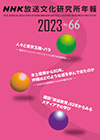
Okinawa—Fifty Years Since the Reversion: What Was Reported and What Was Not by Medias (STUDIES OF BROADCASTING AND MEDIA Vol. 16)
“Studies of Broadcasting and Media” is a research journal launched by the NHK Broadcasting Culture Research Institute in 2003, on the 50th anniversary of the commencement of television broadcasting. The 16th issue of the journal has recently been completed.
This issue features Okinawa that celebrated its 50th year since the reversion to Japan in 2022. What did, or did not, the media in mainland Japan and in Okinawa report about it? The journal presents papers examining the approaches of diverse media—not only television but also newspapers, the internet, publications, and art—to share issues that have not been sufficiently communicated to the mainland.
Japanese text only-March 20, 2023

NHK BROADCASTING STUDIES
NHK Broadcasting Studies is an English journal dispatched from Atago-yama to broadcasting media researchers and research institutions around the world. Since its first edition was published, this journal has received a flood of correspondence from researchers, universities, and libraries throughout the world, thus proving to be a powerful tool in constructing a global network for the digital broadcasting era.
-English text only- ceased publication since February 28, 2011
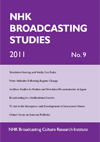
NHK data book: The World’s Broadcasting
While the “NHK data book: The World's Broadcasting” had been published biennially, presenting the current state of the broadcasting industry by country and region, it has been published annually since the 1999 edition in order to meet demands to track the drastic changes and movements in the world's broadcasting media.
-Japanese text only- March 25, 2023

The NHK Yearbook 2023
This publication is the only one of its kind to accurately record the year's activities, not only of
NHK but also that of the broadcasting field in Japan and abroad.
It is edited with the aim of “presenting the information to viewers.” Originating in 1931 under the
name, “The Radio Yearbook,” it has been published annually ever since, with the exception of the
wartime period.
-Japanese text only- October 30, 2023

Books
The NHK Monthly Report on Broadcast
Research:
Research Results on the Paralympic Games (September 2017 Special Edition)
This special issue of the Institute’s monthly journal presents research findings on the Paralympic
Games and broadcasting. Along with diverse studies conducted by NHK researchers on the Rio 2016
Paralympics, the journal also carry a paper contributed by an external academic researcher on the
changes in social background and values in “people with impairment engaging in sports.”
Creating a more inclusive society where everyone can live equally, with or without impairment, is one
of the goals of the Paralympics. What should and can broadcasters do to achieve this goal? As the
Tokyo 2020 Paralympics approaching, we hope this publication will inspire the readers to consider the
roles of “public service media.”
-Japanese text only- September 1, 2017
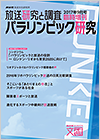
NHK's New Dictionary of Japanese Pronunciation and Accentuation
The Japanese Language Pronunciation and Accent Dictionary has been revised as NHK's New Dictionary of Japanese Pronunciation and Accentuation. The renewed version covers “pronunciation and accentuation appropriate for broadcast use” based on vast amounts of, and detailed, database including the results of the survey of NHK announcers. The volume contains 75,000 words. It is an easier-to-use dictionary with a new policy on accent marks and entries conforming to the conventional style of other Japanese dictionaries.
-Japanese text only- May 25, 2016
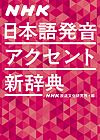
NHK Data Book 2015 National Time Use Survey
Since 1960, NHK’s National Time Use Survey has been conducted every five years in order to grasp an
actual condition of Japanese people’s lives by looking into their time usage for daily activities such
as sleep, work, meals, TV-viewing, and Internet use. The book reports the findings from the latest
survey conducted in October 2015 with detailed data including the participation rate (‘doers’ ratio’)
for every 15 minutes and the amount of time spent for each activity, both nationwide and by gender,
generation, occupation, type of educational institute, city size, etc.
These data are used for NHK’s programing as well as for social statistics studies. They also serve as
a useful reference for the media personnel and marketing researchers.
-Japanese text only- March 1, 2016
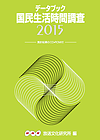
NHK kanji hyoki jiten (NHK Dictionary for Writing Kanji)
Major revision of the earlier publication NHK shin yoji-yogo jiten (NHK New Kanji and Word Usage Dictionary. Reflecting changes made for the first time in 29 years in the Joyo Kanji or essential and general-use characters established by the Japanese government, this book gives some 35,000 words. Additions and changes regarding examples, synonyms, etc. were made to some 2,200 entries.
-Japanese text only- October 15, 2015

Gendai Nihonjin no ishiki kozo, dai-7 kan
(The Structure of Japanese Attitudes Today; 7th ed.)
The “Japanese Value Orientations” (Nihonjin no ishiki) surveys designed to assess attitudes and opinions of Japanese have been held every five years since 1973. The 2008 survey was the eighth in the series. The questions ask about the nature of respondents’ family and work, life goals, interpersonal relations, and attitudes toward politics and internationalization. Providing analyses of data accumulated over 35 years, the volume shows how attitudes have changed over time and perspective on the future of Japanese society.
-Japanese text only- February 25, 2010

Gendai shakai to media, kazoku, sedai (Media, the Family, and the Generations in Society Today)
This is a collection of articles written on the occasion of the 30th anniversary of the “Japanese Value Orientations” surveys held every five years since 1973 by the NHK Broadcasting Culture Research Institute. Basing their arguments in the vast survey data accumulated through the tracing of Japanese ways of thinking and values over three decades, up-and-coming researchers in various fields offer insights on the media and audiences in society today.
-Japanese text only- March 31, 2008

Nihonjin no suki na mono: Deta de yomu shiko to kachikan (What Japanese Like: Data on Preferences and Values)
What are your favorite foods, animals, landscapes, sports, ways of spending free time, seasons, words, music, colors, numbers . . . ? Based on trends in tastes drawn from analysis of a large-scale survey on “what Japanese like” conducted at 300 locations throughout the country by the NHK Broadcasting Culture Research Institute, this volume presents the facts of Japanese values and living circumstances as of 2008.
-Japanese text only- January 10, 2008

Kokugo-ryoku tesuto (Improve Your Language Skills) series
Kokugo-ryoku appu 400 mon (400 Questions to Improve Your Language Skills)
Questions on common-sense Japanese and questions on kanji
Solving questions with fun will
improve your language skills spontaneously [before you realize it].
Published May 10, 2003

Kokugo-ryoku motto appu 400 mon (Further Increase Your Japanese Language Power: 400 Questions)
Published April 10, 2004

Kokugo chikara toreningu 400 mon (Japanese Language Power Training: 400 Questions)
Published October 10, 2007

Nihonjin no seikatsu jikan 2005: NHK kokumin seikatsu jikan chosa (Japanese Time Use 2005: The NHK National Time Use Survey)
Based on the results of the 2005 “Japanese Time Use” survey conducted every five years since 1960, this book sets forth a clear picture of the ways Japanese used time in 2005 with a wealth of tables and charts. A valuable source of data for understanding Japan at the time of publication. The first half of the book focuses on specific activities?sleep, housework, work, use of free time and use of media with detailed commentary on findings and changes. The last half of the book takes up circumstances and issues of society today under the themes of the continuing trend toward long working hours amid the so-called business recovery, the lives of women against the backdrop of smaller families and later marriages, how the lives of students changed as a result of the adoption of the five-day school week, and the lives of older people, whose diverse lifestyles cannot easily be categorized in Japan’s rapidly aging society.
-Japanese text only- December 25, 2006

Hoshoku to hoshoku: NHK Nihonjin no shoku-seikatsu chosa kara (Irregular and Indiscriminate Eating: From the NHK Survey on Japanese Eating Habits)
Perspectives on eating patterns in the twenty-first century based on the “Japanese Eating Habits Survey.”
-Japanese text only- December 10, 2006

NHK Handbook of Japanese Language
The latest data base of modern Japanese language usage in broadcasting. As for pronunciation of a numeral and usage of Jyosu-shi without a similar book. Kana lexicology of words taken from foreign languages is inserted at the end of the book.
-Japanese text only- February 15, 2017

NHK kisho/saigai handobukku (NHK Handbook on Weather and Disasters)
Everything you need to know about weather and disasters explained in easy-to-understand language. An indispensable guide for people working in the media and in disaster prevention. Major revision of the earlier publication Kaiteiban NHK kisho handobukku (NHK Weather Handbook Revised Edition).
-Japanese text only- November 30, 2005

Gendai Nihonjin no ishiki kozo, dai-6 han (The Structure of Japanese Attitudes Today; 6th edition)
Offers a complete grasp of changes in Japanese ways of thinking and values as seen in the results of the 6th “Japanese Value Orientations” survey of 2003. The survey is held every five years with a sample of 5,000 people. Analyses and breakdowns provided in a wealth of charts and tables. The year 2003 marking 30 years since the surveys were begun was also a time of great changes in the structures supporting Japan since the end of World War Ⅱ?politically, economically, and in terms of international relations. This book offers valuable data giving a bird’s-eye view of the changes in Japanese attitudes in the time span of one generation. The results of this first survey of the twenty-first century, which is predicted to be a time of great change, present a true picture of what Japanese are like today.
-Japanese text only- December 20, 2004

Dictionary of Writing and Wording: Third Edition
This is a dictionary for the Chinese characters used in broadcasting, such as those included in the national list of Kanji (Chinese characters) in common use. It compiles living words in modern usage from various fields. Coinciding with the applicable word additions made in 2002, this third edition was completed with approximately 400 newly revised headings.
-Japanese text only- March 31, 2010

Terebi shicho no gojunen (Fifty Years of Watching Television)
What has television broadcast over the years and how do people watch it? Marking the 50th anniversary of the beginning of television broadcasting in Japan, this book presents a clear picture of the path of television programming as it has reflected society over half a century and viewer trends explained on the basis of accumulated knowledge and opinion poll data. The book is divided into two parts, with the first part showing the changes in television programming over 50 years from the early days of television to the present. The second part looks at what viewers re like today after watching such programs over fifty years based on survey data and also considers how people see the role of television. The book ends with a look at the future prospects of television after the digitalization of broadcasting.
-Japanese text only- November 30, 2003

The Survey on the Ways of Life and Attitudes of Junior and Senior High School Students
Through an extensive and thorough analysis of survey data, this publication reveals the ways of life and the attitudes of junior and senior high school students in 21st Century Japan. This is a companion for those in the educational field and parents of junior and senior high school students. It is filled with exclusive interviews with experts and columns that help in understanding teenagers.
-Japanese text only- June 25, 2003

Beyond Analog Television:Digital Television Broadcasting in the World
This is the image of future television! The source of a wealth of information on digital terrestrial broadcasting! Digital terrestrial broadcasting is finally starting in the three major metropolitan areas of Tokyo/Osaka/Nagoya on December 1, 2003. This is a book that opens up a door to the world of digital terrestrial broadcasting. It enlarges upon approaches being made in leading countries in the field, such as the United Kingdom and the United States, which launched their services in 1998, and gives specific examples of their plans.
-Japanese text only- April 26, 2003

Hoso no nijusseiki: Radio kara terebi, soshite ta-media e (Broadcasting in the Twentieth Century: From Radio to Television and then to the Multimedia Age)
How has broadcasting been connected to the social trends and culture of each era? How has broadcasting influenced the way people live? This is a history of broadcasting informed by images of the aspirations and passions that reporters, directors, announcers, technicians and others poured into broadcasting, both at NHK and the commercial broadcasters. The volume tells stories of many of the memorable programs that Japanese listened to and watched most closely.
-Japanese text only- March 27, 2002

The History of Broadcasting in Japan in the 20th Century
“The History of Broadcasting in Japan in the 20th Century” is a full-scale comprehensive chronicle of broadcasting. Twenty four years have passed since a book of this type, “50 Year History of Japanese Broadcasting,” was published in 1977. This extraordinary book was compiled as part of the 75th anniversary of broadcasting in Japan, after more than five years of research by the NHK Broadcasting Culture Research Institute.
-Japanese text only- March 25, 2001

Attitude Structure of Contemporary Japanese People (5th Edition)
NHK's survey “The Consciousness Structure Attitudes and Awareness of Japanese Today,” which is held once in every five years covering 5,000 people, thoroughly analyzes changes in Japanese ways of thinking and sense of values. Analysis is made with large amounts of data on various aspects of changing attitudes and awareness. These include: the declining ratio of people favoring efficiency in economic activities; growing emphasis on human feelings and harmony with others; declining importance given to all-out association in every aspect; changes in the long-standing family roles of husbands working outside while wives doing housework; and less of enthusiasm for politics. This publication can help in understanding major trends and issues in Japan today.
-Japanese text only- February 20, 2000

Dictionary of Public Opinion and Audience Surveys
This being the first public opinion survey encyclopedia in Japan is presented in two sections, the first consisting of a manual portion which gives an explanation of the basic knowledge of this type of surveys and then the second which is a glossary of pertinent vocabulary. B5 size, 355 pages.
-Japanese text only- March 28, 1996
